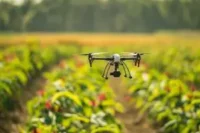Artificial Intelligence Techniques for Smart Weed Management
Published: 17 Aug 2025
Every farmer asks the same question: why do weeds keep coming back no matter how much effort is put into controlling them? Herbicides harm the soil, manual labor drains energy, and weeds still thrive. Is there any smarter, safer, and more effective way to manage them? That’s where Artificial Intelligence enters the scene, reshaping weed control forever.
So, guys, without wasting time, let’s jump into the article to learn the Artificial Intelligence Techniques for Smart Weed Management
1. AI-Powered Weed Detection
- Machine vision cameras scan fields and recognize weeds with incredible accuracy.
- Deep learning models can differentiate between crops and weeds—even if they look almost identical.
- Real-life example: Carbon Robotics’ LaserWeeder uses AI-guided lasers to burn weeds without harming crops.
- Emotional Impact: Farmers no longer need to drown fields in chemicals—AI helps protect both their harvest and the environment.

2. Precision Spraying with AI
- Instead of spraying chemicals across entire fields, AI systems use “See & Spray” technology to target only the weeds.
- John Deere’s AI sprayers reduce herbicide usage by up to 90%.
- This not only saves money but also protects soil health and water from chemical pollution.
- Emotional Hook: Imagine feeding your family with crops grown in healthier soil, free from unnecessary chemicals.
3. Drone-Based Weed Surveillance
- AI-powered drones fly over fields, capturing high-resolution images.
- They map weed-infested areas and guide farmers to act only where needed.
- Drones save hours of labor and reduce costs for large-scale farms.
- Human Touch: Farmers get back precious time for family while technology guards their fields from above.

4. Predictive Analytics for Weed Growth
- AI analyzes weather, soil conditions, and past patterns to predict weed outbreaks.
- Early alerts allow farmers to act before weeds spread uncontrollably.
- This reduces crop loss and ensures steady harvests.
- Emotional Connection: Farmers can plan with confidence instead of living in fear of unpredictable weed invasions.
5. Robotic Weed Control
- Robots equipped with AI vision and arms pull or destroy weeds automatically.
- These robots work day and night without fatigue.
- They ensure crops grow stronger by removing competition early.
- Sustainability Angle: No chemicals, no pollution — just smarter farming for a greener planet.

6. AI and Sustainable Farming
- AI helps farmers use the right amount of water, fertilizer, and pesticides to reduce waste.
- AI-powered irrigation systems save water by checking soil moisture and weather.
- Drones and robots detect pests and weeds early to cut down chemical use.
- AI monitors soil health and keeps it fertile for future crops.
- Weather predictions with AI help farmers prepare for climate challenges.
- AI improves crop yields while lowering the carbon footprint of farming.
7. AI-Powered Farmer Decision Support Systems
- Beyond machines and drones, AI also acts as a decision-making partner for farmers.
- It gathers data from satellites, soil sensors, and historical patterns to give farmers step-by-step guidance on when and how to manage weeds.
- AI tools recommend the best timing for spraying, manual removal, or robotic control, ensuring maximum results with minimum effort.
- Emotional Hook: Instead of feeling alone in the fight against weeds, farmers now have a digital companion that understands their land better than ever.
FAQs about Artificial Intelligence Techniques for Smart Weed Management
Here are some of the most frequently asked questions about the FAQs about Artificial Intelligence Techniques for Smart Weed Management
It might seem that way, but chemicals harm the soil, water, and even our health. AI introduces smarter methods that detect weeds early and reduce chemical use.
AI uses cameras and sensors that “see” plant shapes, colors, and growth patterns. This helps machines know which plant to save and which one to remove.
At first, yes, they may seem costly. But AI-powered tools save money in the long run by reducing labor, chemical use, and crop losses.
Manual weeding is tiring, time-consuming, and not practical for large farms. AI automates the process, making it faster and less labor-intensive.
Not fully, but it can greatly reduce their use. By targeting weeds directly, AI prevents blanket spraying across fields.
It may sound complex, but AI systems are built with easy-to-use apps, sensors, and machines. Farmers only need simple training to operate them.
AI models are trained on thousands of plant images to avoid such errors. Over time, they become more accurate than human eyes.
Conclusion:
Artificial Intelligence Techniques for Smart Weed Management focus on using advanced tools like computer vision, machine learning, drones, and robotics to identify, monitor, and remove weeds more efficiently. Instead of relying heavily on harmful chemicals or manual labor, these AI-driven methods save time, protect crops, and support sustainable farming. Knowing these techniques is important because they not only increase crop yields and reduce costs but also ensure healthier food production and a safer environment for future generations.

- Be Respectful
- Stay Relevant
- Stay Positive
- True Feedback
- Encourage Discussion
- Avoid Spamming
- No Fake News
- Don't Copy-Paste
- No Personal Attacks

- Be Respectful
- Stay Relevant
- Stay Positive
- True Feedback
- Encourage Discussion
- Avoid Spamming
- No Fake News
- Don't Copy-Paste
- No Personal Attacks





